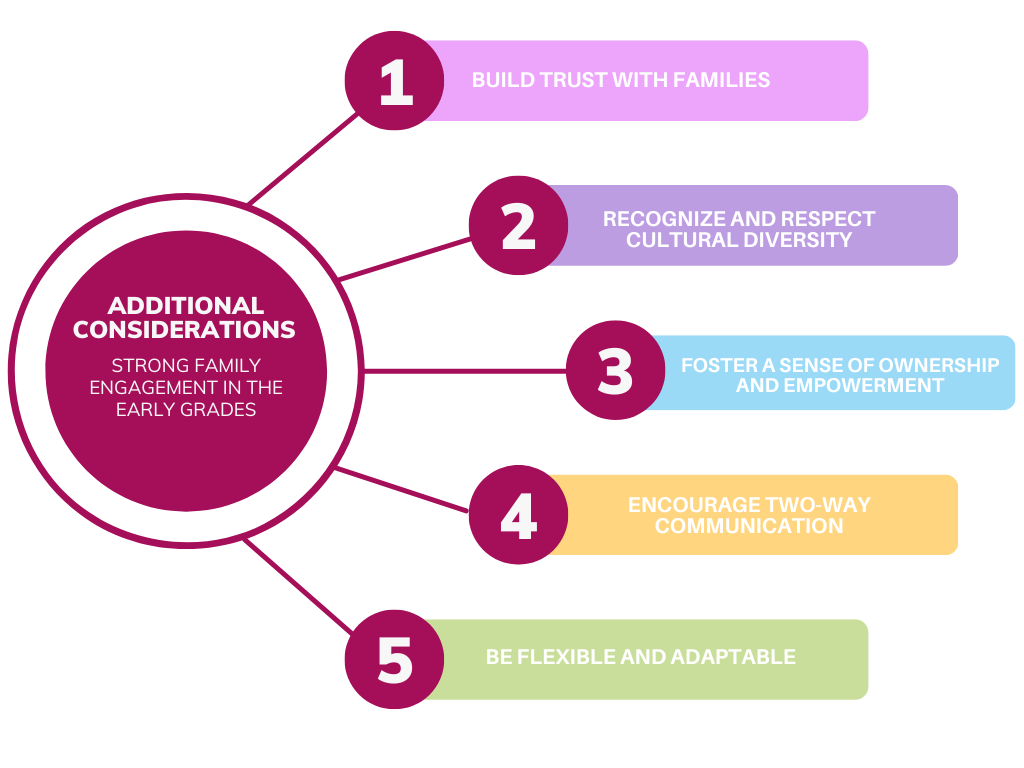
Family Engagement: Key to Early Education Success
Author: Austin Stanfel
Strong family engagement is crucial for student success in the early grades. Children who receive support from their families are likelier to have positive attitudes toward school, perform better academically, and develop critical social skills. However, establishing a solid family engagement can be challenging, especially for schools with limited resources. In this article, we will discuss some strategies schools can use to create a culture of family engagement in the early grades.
Establish a welcoming and inclusive school environment.
The first step to creating a culture of family engagement is to establish a welcoming and inclusive school environment. Parents should feel comfortable and respected when they enter the school and be encouraged to participate in school activities. One way to achieve this is to provide information about school policies and procedures in multiple languages and formats, including online resources and printed materials.
Schools can also host events that bring families and staff together, such as back-to-school nights, family fun nights, and parent-teacher conferences. These events allow families to get to know the staff and other families and learn about the school’s curriculum and expectations.
Provide opportunities for family involvement.
Another critical strategy for promoting family engagement is to provide opportunities for family involvement in the school. This can include volunteering, attending school events, and participating in decision-making processes.
Schools can invite families to participate in classroom activities like reading with students or leading art projects. They can also create advisory committees or parent-teacher associations that allow families to provide input on school policies and initiatives.
Engage families in their child’s learning.
Engaging families in their child’s learning is essential to solid family engagement. Schools can provide families with information about each grade level’s curriculum, learning objectives, and resources for supporting their child’s learning at home.
Teachers can also communicate regularly with families about their child’s progress and provide suggestions for how families can support their child’s academic growth. This can include providing resources for reading at home, practicing math skills, and developing study habits.
Use technology to facilitate communication.
Technology can be a powerful tool for facilitating communication between schools and families. Schools can use online portals to provide families with access to grades, attendance records, and other important information. They can also use email and social media to communicate with families about school events and initiatives.
Teachers can use technology to share lesson plans, assignments, and feedback with families. This can help families understand what their child is learning and provide opportunities for them to support their child’s academic growth.
Develop partnerships with community organizations.
Developing partnerships with community organizations can also be an effective strategy for promoting family engagement. Schools can partner with local libraries, museums, and other organizations to provide students and families with opportunities for learning and enrichment outside the classroom.
These partnerships can also provide families with resources and support for addressing issues related to health, nutrition, and other social needs. For example, schools can partner with local food banks to provide families access to nutritious food or with community health organizations to provide access to medical services.
Create a supportive school-home connection.
Finally, creating a supportive school-home connection promotes strong family engagement. Schools can provide families with resources for addressing issues related to health, nutrition, and other social needs. This can include information about community resources and support services, and opportunities for families to connect with other families in the school community.
Teachers can also create positive relationships with families by providing regular feedback and praise for their child’s progress. They can communicate regularly with families and provide opportunities for families to ask questions and provide feedback.
In addition to the strategies outlined above, there are some additional considerations that schools can keep in mind when setting up strong family engagement in the early grades:
1. Build trust with families: Building trust with families is crucial for promoting family engagement. Schools can do this by being transparent about their policies and procedures, communicating regularly and effectively with families, and following through on their commitments.
2. Recognize and respect cultural diversity: Schools should recognize and respect the cultural diversity of their students and families. This means being aware of different cultural norms and practices and trying to accommodate and celebrate them. Schools can also provide resources and support for families who are new to the community or who may be facing language barriers.
3. Foster a sense of ownership and empowerment: Families are more likely to engage with the school when they feel a sense of ownership and empowerment. Schools can promote this by providing opportunities for families to provide input on school policies and initiatives and giving them a voice in decision-making processes.
4. Encourage two-way communication: Effective communication is a two-way street. Schools should communicate important information to families and listen to their feedback and suggestions. Schools can provide opportunities for families to ask questions and provide feedback and should be open to their input.
5. Be flexible and adaptable: Finally, schools need to be flexible and adaptable regarding family engagement. Families may have different needs and preferences regarding their involvement in the school community, and schools should be able to accommodate these differences. This may mean offering a variety of ways for families to engage, such as through volunteering, attending events, or providing feedback online.
By considering these additional considerations, schools can create an inclusive, respectful, and influential family engagement culture. Family engagement is not a one-size-fits-all approach, and schools should be willing to adapt and adjust their strategies based on the needs and preferences of their families. With a strong partnership between schools and families, students can thrive academically and socially in the early grades and beyond.
In conclusion, strong family engagement is critical for student success in the early grades. Schools can promote family engagement by establishing a welcoming and inclusive school environment, providing opportunities for family involvement, engaging families in their child’s learning, using technology to facilitate communication, developing partnerships with community organizations, and creating a supportive school-home connection. By implementing these strategies, schools can help families feel valued and connected to their child’s education and provide students with the support they need to succeed academically and socially.
It is important to note that creating a culture of family engagement requires ongoing effort and commitment from schools and families alike. Schools should regularly evaluate their family engagement efforts to identify areas for improvement and seek feedback from families to ensure that their needs and expectations are being met.
Families can also actively promote family engagement by staying informed about their child’s education, attending school events, and volunteering in the school community. By working together, schools and families can create a strong partnership that supports student success and fosters a lifelong love of learning.
In summary, strong family engagement is essential for student success in the early grades. By creating a welcoming and inclusive school environment, providing opportunities for family involvement, engaging families in their child’s learning, using technology to facilitate communication, developing partnerships with community organizations, and creating a supportive school-home connection, schools can promote family engagement and support students in achieving their full potential.


